Product Overview
Parts used: Fresh or dried aerial parts
TCM category: Herbs that clear Heat and relieve Toxicity
TCM nature: Cool
TCM taste(s): Pungent
Meridian affinity: Lung
Scientific name: Houttuynia cordata
Other names: Fish mint, Fish leaf, Rainbow plant, Chameleon plant, Heart leaf, Fish wort, Chinese lizard tail, Bishop's weed
Use of houttuynia (Yu Xing Cao) in TCM
Please note that you should never self-prescribe TCM ingredients. A TCM ingredient is almost never eaten on its own but as part of a formula containing several ingredients that act together. Please consult a professional TCM practitionner, they will be best able to guide you.
Preparation: Remove impurities and dry if using dry.
Dosage: 15 - 40 grams
Main actions according to TCM*: Expels Heat and toxins. Reduces inflammation and expels pus. Dispels Damp-Heat and stimulates urination.
Primary conditions or symptoms for which houttuynia may be prescribed by TCM doctors*: Lung abscess Dyspnea Dysentery Coughing Carbuncles Sores Colitis Urinary tract infection
Contraindications*: This herb is contraindicated for those with Cold from Deficiency symptoms.
Common TCM formulas in which houttuynia are used*:
For aiding in the withdrawal from tobacco addiction combine houttuynia with ginseng (Ren Shen), mulberry bark (Sang Bai Pi), snake gourds (Gua Lou) and platycodon roots (Jie Geng).
For Lung abscess and tobacco toxicity combine houttuynia with fritillary bulbs (Chuan Bei Mu) and job's tears (Yi Yi Ren).
For hot phlegm and lung abscess combine houttuynia with wax gourd (Dong Gua), platycodon roots (Jie Geng) and honeysuckle flowers (Jin Yin Hua).
Key TCM concepts behind houttuynia (Yu Xing Cao)'s properties
In Traditional Chinese Medicine (TCM), houttuynia are plants that belong to the 'Herbs that clear Heat and relieve Toxicity' category. Herbs in this category are used to clear inflammatory and infectious conditions, referred to as 'Internal Heat' in TCM. This is why most of the herbs in this category will have both antibacterial and antiviral properties. In TCM one has too much 'Heat' in their body as a result of a deficiency of 'Yin' (which is Cold in nature, see our explanation on Yin and Yang) or, more commonly, an excess of Yang (Hot in nature). Herbs that clear Heat and relieve Toxicity treat the latter while, at the same time, removing infectious toxins from the body. As such they tend to be Cold or Neutral in nature.
As suggested by its category houttuynia are plants that are Cool in nature. This means that houttuynia tend to help people who have too much "heat" in their body, although with less effect than a plant that would be Cold in nature. Balance between Yin and Yang is a key health concept in TCM. Those who have too much heat in their body are said to either have a Yang excess (because Yang is Hot in nature) or a Yin deficiency (Yin is Cold in Nature). Depending on your condition houttuynia can help restore a harmonious balance between Yin and Yang.
Houttuynia also taste Pungent. The so-called "five elements" theory in Chinese Medicine states that the taste of TCM ingredients is a key determinant of their action in the body. Pungent ingredients like houttuynia tend to promote the circulations of Qi and body fluids. That's why for instance someone tends to sweat a lot when they eat spicy/pungent food.
The tastes of ingredients in TCM also determine what organs and meridians they target. As such houttuynia are thought to target the Lung. In addition to performing respiration, the Lungs are thought in TCM to be a key part of the production chain for Qi and the body fluids that nourish the body.
Use of houttuynia (Yu Xing Cao) as food
Houttuynia are also eaten as food. It is used as an ingredient in dishes such as Fish mint salad.








